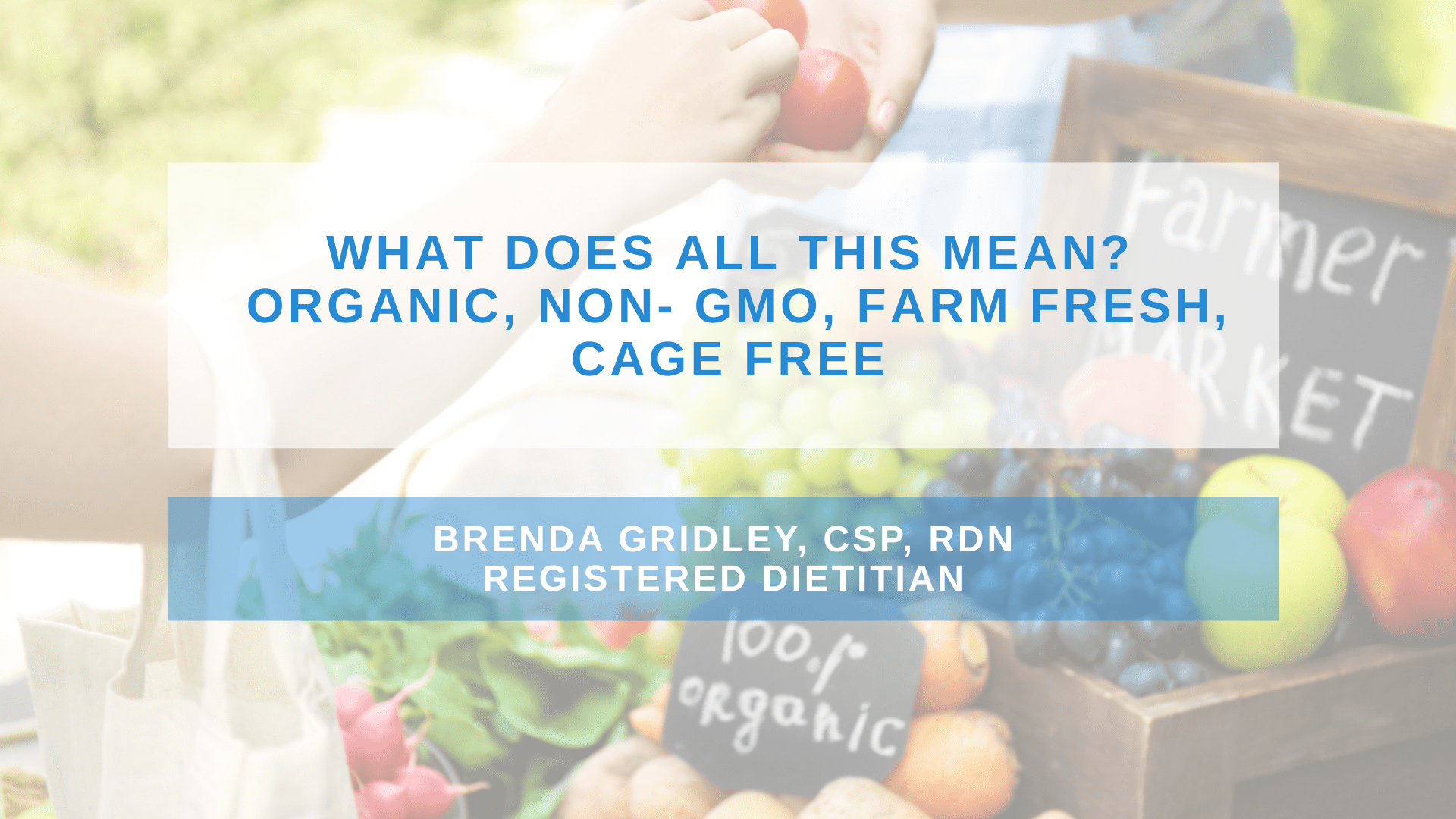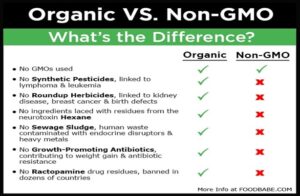
Posted 7 months ago
What does all this mean? Organic, Non- GMO, Farm Fresh, Cage Free.
There’s a lot of confusion and debate about what non-GMO, Farm Fresh and Organic labels really mean. The labels vary so it is important to understand the difference if you want to pick out the healthiest and safest food for you and your family.
USDA organic regulations prohibit any genetically modified (GMO) ingredients in a certified organic product. NOTE: The USDA Organic label certifies that 95%-100% of the ingredients are organic, so there is a slight chance that (up to 5%) of non-organic ingredients are in the product – however they are not supposed to be GMO.
Organic crops cannot be grown with synthetic pesticides and contain much lower pesticide residues overall. Organic regulations prohibit certain toxic pesticides from being used on crops, but there are no special restrictions for non-GMO crops and the non-GMO label claim is unregulated by the FDA.
Organic vs. Cage Free
“Organic” and “cage-free” are labels commonly seen on egg cartons or poultry products, but they refer to different standards:
– Organic: Means the animals were raised according to USDA organic standards. This includes being fed organic feed (no GMOs, antibiotics, or synthetic pesticides), having access to the outdoors, and living in conditions that accommodate their natural behaviors.
-Cage-free: Means the hens are not kept in cages and can roam in a barn, but they may not have outdoor access. Cage-free doesn’t guarantee organic feed or other organic practices.
Here’s a breakdown comparing organic and cage-free eggs based on nutrition, animal welfare, and shopping decisions:
1. Nutrition
-Organic Eggs:
Slightly higher omega-3s and vitamins in some cases due to better diets (organic feed, possibly pasture access).
-Cage-Free Eggs:
Nutritionally like conventional eggs unless they’re also labeled pasture-raised, or omega-3 enriched.
Bottom Line: Not a huge nutritional difference unless organic eggs come from hens with outdoor access and a varied diet.
2. Animal Welfare
-Organic:
Better welfare standards. Hens must have outdoor access, space to roam, and enrichment.
-Cage-Free:
Better than caged systems, but hens may still live in crowded barns with limited enrichment and no required outdoor time.
Bottom Line: Organic generally ensures higher welfare than cage-free alone.
3. Shopping Decisions
-Cost:
Organic eggs are typically the most expensive due to stricter standards and feed costs. Cage-free eggs are mid-range.
-Label Clarity:
Terms like “organic” are regulated by the USDA. “Cage-free” is regulated too, but less comprehensive.
Bottom Line: If budget allows and welfare is a priority, organic is the better option. If you’re improving from conventional eggs but watching costs, cage-free is a step up.
Farm Fresh
The term “farm fresh” generally refers to food products, especially fruits, vegetables, eggs, dairy, or meat that are:
- Recently harvested or produced
- Minimally processed
- Perceived as natural or wholesome
It implies that the product comes directly from a farm and hasn’t gone through long storage, heavy processing, or excessive transportation.
Important note: “Farm fresh” is not a regulated term in many countries (like the U.S.), so it can be used in marketing without strict standards. It often appeals to consumers seeking freshness, quality, and local sourcing, but doesn’t guarantee organic or chemical-free production.
Here are a few common examples of how “farm fresh” is used in food labels and marketing:
- Egg Cartons
Label: Farm Fresh Eggs
Implied Meaning: The eggs are recently laid, possibly from local farms. However, this doesn’t necessarily mean they are free-range or organic unless specified.
- Produce Baskets or Boxes
Label: Farm Fresh Vegetables – Straight from the Field
Implied Meaning: Vegetables were picked recently and may come directly from a local farm. Often used by farmers’ markets or CSA (Community Supported Agriculture) boxes.
- Dairy Products
Label: Farm Fresh Milk – From Grass-Fed Cows
Implied Meaning: Milk is fresh and potentially more natural, especially if it mentions grass-fed or no added hormones.
- Butcher or Meat Market Ads
Label: Farm Fresh Meats – Locally Raised
Implied Meaning: Meat is locally sourced, possibly with fewer preservatives or from smaller-scale farms.
- Restaurants or Cafés
Menu Description: Farm Fresh Omelet – Made with local eggs, seasonal veggies
Implied Meaning: Ingredients are locally sourced, seasonal, and high-quality.
Despite these claims, always look for certifications (e.g., USDA Organic, Certified Humane, etc.) if you’re seeking specific standards like organic, antibiotic-free, or humane treatment.
For updated reports visit www.EWG.org
The Dirty Dozen List and Clean 15 List
EWG’s Dirty Dozen
- Strawberries
- Spinach
- Kale, collard and mustard greens
- Grapes
- Peaches
- Pears
- Nectarines
- Apples
- Bell and hot peppers
- Cherries
- Blueberries
- Green beans
EWG’s Clean 15
The Clean 15 list includes produce that is least likely to be contaminated by pesticides.
- Avocados
- Sweet corn
- Pineapple
- Onions
- Papaya
- Sweet peas (frozen)
- Asparagus
- Honeydew melon
- Kiwi
- Cabbage
- Watermelon
- Mushrooms
- Mangoes
- Sweet Potatoes
- Carrots
Brenda Gridley, CSP, RDN
Brenda is originally from Los Angeles, CA where she attended California State University of Los Angeles for her under graduate degree in Nutritional Science. She began her career with Kaiser Permanente in 2004. Throughout her professional development, she has worked in Cardiology and open heart surgery, Renal/Dialysis, organ transplants and Oncology, including chemotherapy, radiation and head and neck. Brenda has extensive experience with weight management programs, including Bariatric and finally Eating disorders and mindful eating. She went on to specialize in the Pediatric population and has maintained her Certification in Pediatric Nutrition since 2011. Areas she has managed include pediatric and neonatal intensive care units where she was responsible for individualizing therapeutic diets and alternate nutrition support based on specific metabolic needs, medical conditions, and cultural preferences.
Her passion for nutrition was developed at a young age and reared by her grandmother who always instilled the importance of a healthy diet and active lifestyle. When her grandmother became ill, Brenda became aware of the impact nutrition plays in disease prevention and maintaining overall mind and body health. She cared for grandmother until she passed and has made it her goal to help others achieve their full “nutrition potential” with using a culturally sensitive holistic approach.
She is married with two beautiful daughters and in her spare time she enjoys watching movies with her children, experimenting with new recipes, reading mystery novels, running and Yoga.
Please ask your Ironwood Cancer & Research Centers provider for a referral to see our dietary counselors.


